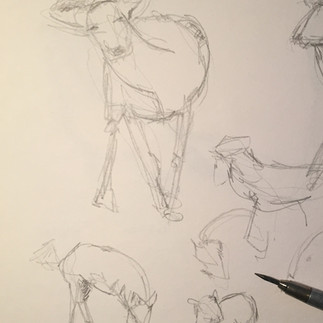Tips for Sketching Animals
- Gretchen Halpert
- Feb 25, 2022
- 2 min read
Updated: Aug 30, 2022
In the SIDP, we draw as much as possible from life, where we can turn objects around, see all sides, touch, feel, smell, observe, measure. What are our options, then, for drawing moving animals? (Animals include birds, reptiles, etc..)
1. Draw from life whenever possible, filling your page with quick gesture drawings. Keep your eyes on your subject, not your page. One to five second sketches are about all you have time for. Movement, motion, posture. Shapes, not details.
2. Observe, then close your eyes. An image may stick in your memory long enough for you to record that frozen image. Try it!
3. Animals often return to the same position, so you can return to your sketches, filling in the blanks. It doesn’t need to be the same creature; one herring gull substitutes for another. Here, you can refine beak, body, wing shape.
4. With mammals, begin with the backbone. Once the backbone, including neck and tail, is in place, you have a posture. Refine when the animal, or its friend, returns to that posture.
5. Make color notes. Remember lighting conditions affect color (dark, stormy skies versus summer afternoon light versus studio lighting).
6. Take photographs and videos when you’re done sketching. The former freezes motion for you, and the latter gives you both movement and stillness. You can see how the creature was moving the second prior and after you snapped a still image.
7. Now you can look at close-up professionally prepared images for important details your sketches and photographs didn’t capture.
How is this preferable to finding a fabulous photograph of an animal you’ll never see in person on the internet?
1. This image belongs to someone else. If you use it for reference, obtain permission from the copyright holder if you are copying any portion of it. If it’s open source, use as one of your many reference photographs for reasons below.
2. You didn’t take the photograph; therefor, you did not experience the air, the environment, the habitat, the experience of watching your subject move in real life. This lack of connection often shows in a novice’s finished drawing.
3. You cannot see around the sides and in the shadows. With your own photographs or with videos, you have multiple images of the same subject that can help inform your final artwork.
What else can you do?
Learn anatomy. Sketching a flying bird and leaping canine is much easier when you know the basic anatomy of birds and mammals. We all have the same bones and muscles; they are just arranged differently. Understanding anatomy helps a posture make sense.
Here are some references you may find useful. There are many ; this is just to get you started. Feel free to add your own favorites in the comments area.
An Atlas of Animal Anatomy for Artists by Wilhelm Ellenberger
Stripped Bare: The Art of Animal Anatomy by David Bainbridge
Animals in Motion by Eadweard Muybridge
Science of Creature Design: understanding animal anatomy by Terryl Whitlatch
Free download of "Tips For Sketching Animals" below





